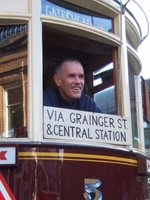The traditional May Day Bank Holiday began today, so although we spent yesterday in London, we decided to still go away for the remainder of the long weekend.
A last minute decision allowed us to follow the sunshine, and the best area closest to London was Norfolk. We arranged accommodation in Kings Lynn, but before exploring the town, we did a circular AA tour starting and ending there.
The first stop on the tour was actually a lunch break for us, as it took 2.5 hours to reach here from London. Castle Rising is a great little town, with all the ingredients needed for interest – historic church, great almshouses a ruined castle and a brilliant little tearooms in a lovely period cottage with sheltered garden.
From here the tour passed by the Royal Holiday home at Sandringham, and nearby is Wolferton, a fascinating tiny town, which basically is only there because it was the Royal Railway Station. When King Edward VII & Queen Alexandra visited Sandringham, they alighted here at their own private train station. The train line is now gone, and the buildings are all private dwellings.
The tour continued through the lovely Burnham towns and onto Holkham Hall, where it was time for another cup of tea.
Down the road is the lovely town of Little Walsingham. This was a pilgrimage town, and there is certainly a wonderful feel to this town, and the tranquil old ruined abbey.
The route then took us through Castle Acre – another wonderful castle town, before reaching King's Lynn. After checking into a lovely room in our Victorian house hotel at Stuart House, we explored the town. This was once a prosperous port, dating back to the 12th century.
There are many wonderful old buildings in the old part of town, adjacent to the river and old port. The church also dates from the 12th century, and is one of the largest for a town of that size, in the country. The town looks prosperous, and not suffering from the recession, we really enjoyed exploring it.
Showing posts with label Abbey. Show all posts
Showing posts with label Abbey. Show all posts
Wednesday, May 04, 2011
Thursday, December 16, 2010
Bridges & Churches of English counties – 11 December 2010
Everywhere we visit in England is steeped in history. This weekend we kept meeting references to Hereward the Wake and also King John. There are names like these that we have heard of, but would be hard pushed to give a synopsis of their lives.
We took the scenic route on our way to Stamford for the weekend. Stamford is a delightful stone town at the northern end of the Cotswold Stone seam and is much loved by period film directors. The route we took passed through several similar styles of towns, although on a smaller scale. First, Titchmarch, with it's stylish church surrounded by a ha-ha, normally seen around a country home. Then Oudle, a lovely town with a prestigious boys school owed by the Worshipful Company of Grocers, many cafes and today a street market selling country delights like rabbit or game bird pies.
The final town in this series before we arrived at Stamford, was Wansford. A curving stone bridge unites the two halves of this picturesque town.
From Stamford we drove a circular tour along the edge of the fens (large flat areas, where the frequent church spires stand out like beacons), to Crowland. We have previously enjoyed visiting this lovely old town with two special items of interest; the remains of a triangular medieval bridge, and the abbey. The current church is in one isle of the old ruined abbey. It is this church that had the first peal of bells installed in about 986, the ropes are the longest in the country and these bells were the first to be broadcast on radio in 1923.
We really enjoyed our delicious lunch in the 'Old Copper Kettle' tearooms in Crowland where they quote an airman who met his girlfriend there during WWII and said it was a “place where we both felt secure and could be ourselves”.
Not far from here is another abbey incorporated into the present church at Thorney. The town has the main street lined with model workers cottages built by the Duke of Bedford to house his workers.
We finished the day in Stamford, enjoying exploring the narrow streets and shops decorated for Christmas, and were inspired by the sunset to rework the old saying – red vapour trails at night; motorists delight.
We took the scenic route on our way to Stamford for the weekend. Stamford is a delightful stone town at the northern end of the Cotswold Stone seam and is much loved by period film directors. The route we took passed through several similar styles of towns, although on a smaller scale. First, Titchmarch, with it's stylish church surrounded by a ha-ha, normally seen around a country home. Then Oudle, a lovely town with a prestigious boys school owed by the Worshipful Company of Grocers, many cafes and today a street market selling country delights like rabbit or game bird pies.
The final town in this series before we arrived at Stamford, was Wansford. A curving stone bridge unites the two halves of this picturesque town.
From Stamford we drove a circular tour along the edge of the fens (large flat areas, where the frequent church spires stand out like beacons), to Crowland. We have previously enjoyed visiting this lovely old town with two special items of interest; the remains of a triangular medieval bridge, and the abbey. The current church is in one isle of the old ruined abbey. It is this church that had the first peal of bells installed in about 986, the ropes are the longest in the country and these bells were the first to be broadcast on radio in 1923.
We really enjoyed our delicious lunch in the 'Old Copper Kettle' tearooms in Crowland where they quote an airman who met his girlfriend there during WWII and said it was a “place where we both felt secure and could be ourselves”.
Not far from here is another abbey incorporated into the present church at Thorney. The town has the main street lined with model workers cottages built by the Duke of Bedford to house his workers.
We finished the day in Stamford, enjoying exploring the narrow streets and shops decorated for Christmas, and were inspired by the sunset to rework the old saying – red vapour trails at night; motorists delight.
Tuesday, July 28, 2009
Stelvio Tour, Day 2 - 26 July 2009
 The morning began driving from Luxemburg (provence of Belgium), over the border into Luxemburg (country) where we used the motorway to skirt around Luxemburg (city) then across the border and into Germany for what was supposed to be a fast run across Germany on the autobahn.
The morning began driving from Luxemburg (provence of Belgium), over the border into Luxemburg (country) where we used the motorway to skirt around Luxemburg (city) then across the border and into Germany for what was supposed to be a fast run across Germany on the autobahn.While we did manage to top 198 kph we also spent great chunks of time when we would have been pleased to be achieve 1/10th of that speed.

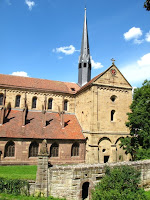
 Our first deviation from the proscribed route was to Landau where we had a quick look at the Romanesque church before enjoying some refreshments in the square. Then back on the autobahn for a few more queues before heading off to find the UNESCO World Heritage Maulbronn Monastery complex.
Our first deviation from the proscribed route was to Landau where we had a quick look at the Romanesque church before enjoying some refreshments in the square. Then back on the autobahn for a few more queues before heading off to find the UNESCO World Heritage Maulbronn Monastery complex. This was well worth the detour as it is a really attractive village set within the Monastic complex, most of which can be seen for free, the only payment required is to enter the Monastery proper, and we were there on a beautiful day so it was at its picture-perfect best.
This was well worth the detour as it is a really attractive village set within the Monastic complex, most of which can be seen for free, the only payment required is to enter the Monastery proper, and we were there on a beautiful day so it was at its picture-perfect best.Then it was back on the autobahn for another high-speed run and some more queues before going into the centre of Ulm to see the tallest church steeple in the world. Leaving Ulm we were thrown off the motorway on a detour for the second time but this time the alternate route was through attractive Bavarian villages with the Alps as a backdrop.


Wednesday, May 06, 2009
Zealand to Zeeland - 2 May 2009

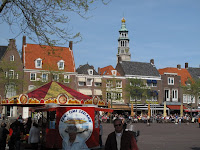
As Kiwis abroad, we decided it was about time we took a look at the original Zeeland.
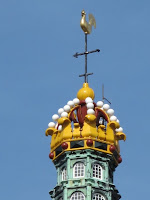 We always thought New Zealand was named by it's first European discoverer, Able Tasman. But apparently it is thought to have been named by Dutch cartographers.
We always thought New Zealand was named by it's first European discoverer, Able Tasman. But apparently it is thought to have been named by Dutch cartographers.An early start got us to Dover for an 8.30 sailing. A three hour drive, including a 6k tunnel, brought us through France and Belgium to Zeeland, the south-western province in the Netherlands.


Middelburg is the largest town. Like one of our favorite towns in Holland, Horne, Middelburg was also a base of the Dutch East India company.


It has several grand old buildings and our B&B was right beside the Abbey, a wonderful complex, now housing several museums and churches. The only draw back, was the Abbey bells, housed in a fabulous bell tower we had admired during the day, marked every quarter hour and rang out the hour, right through the night. But the B&B was still an excellent location, and attached to the Desafinado Jazz cafe, where we enjoyed a delicious dinner.
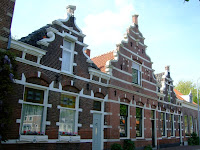

Wednesday, March 25, 2009
Spring in Suffolk - 21 March 2009

This weekend saw London at its best. The sun shone, temperatures were mild, with spring flowers everywhere.

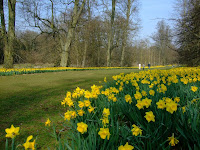
On Saturday we headed north-east to drive a circular route starting at Clare. Leaving this pleasant market town we headed on to Cavendish, with its attractive almshouses and then on to Nowton Park just outside Bury St Edmunds. Once the garden of a stately home, the lime avenue is a blaze of daffodils in the spring, and we were there on the perfect weekend to enjoy their 100,000 bulbs.


From there we drove into the centre of Bury St Edmunds, to enjoy the Abbey, now a ruin, courtesy of Henry VIII. Nearby is St Marys church where Mary Tudor, Henry's sister, is now buried having been moved from the Abbey. Bury claims to have the smallest pub in the country, which can only comfortably seat about six people. We were fortunate and found The Nutshell fairly empty so occupied a significant portion of the seating and enjoyed a drink.
 To the west of Bury St Edmunds is Ickworth House. This stunning country pile, has some very interesting characters in its history, including an agnostic Bishop of Ireland. We enjoyed the gardens as well as looking round the house. One entire wing of the house was built just for the sake of symmetry and for most of its existence had no function; it served as a grain store for the farm for a period but was mostly just a shell.
To the west of Bury St Edmunds is Ickworth House. This stunning country pile, has some very interesting characters in its history, including an agnostic Bishop of Ireland. We enjoyed the gardens as well as looking round the house. One entire wing of the house was built just for the sake of symmetry and for most of its existence had no function; it served as a grain store for the farm for a period but was mostly just a shell.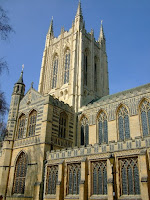 The circular drive took in other towns, the most interesting features were two churches: one, at Great Bradley, with a genuine old Tudor porch and the other, at Kedington, just old and untouched. Old uneven flagstones, old C15th pews, antique triple-decker pulpit and so on. Although this may sound like many churches in England, this one was a real step back into history.
The circular drive took in other towns, the most interesting features were two churches: one, at Great Bradley, with a genuine old Tudor porch and the other, at Kedington, just old and untouched. Old uneven flagstones, old C15th pews, antique triple-decker pulpit and so on. Although this may sound like many churches in England, this one was a real step back into history.
Monday, June 16, 2008
Vale of Glamorgan - 14 June 2008
 The crescent shaped area west of Cardiff, goes by the enticing name of the Vale of Glamorgan. Although we have visited Wales several times we had not been to
The crescent shaped area west of Cardiff, goes by the enticing name of the Vale of Glamorgan. Although we have visited Wales several times we had not been to 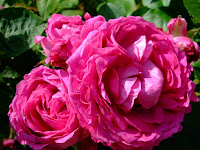 this area so we finally made a weekend trip to explore the Vale. It's only a little over 2 hours from London, providing you get a good run on the M4.
this area so we finally made a weekend trip to explore the Vale. It's only a little over 2 hours from London, providing you get a good run on the M4.Dyffryn Garden is a Grade 1 listed garden, and this was our first stop. To be honest, it wouldn't rate as the best English garden we've seen, but nevertheless, was very pleasant to stroll around in the sunshine.
 Just up the road from the gardens is the Tinkinswood Burial Chamber. Built around 4000BC it has the largest capstone of any such burial chamber in Britain, estimated at weighing 40 tons, it was pretty impressive. The logistics of early civilizations moving and placing this slab are incredible.
Just up the road from the gardens is the Tinkinswood Burial Chamber. Built around 4000BC it has the largest capstone of any such burial chamber in Britain, estimated at weighing 40 tons, it was pretty impressive. The logistics of early civilizations moving and placing this slab are incredible.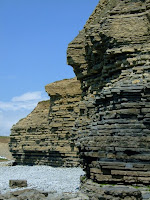 The road through the centre of the Vale was pretty uneventful, but the fascinating thing about Wales is old abbeys and castles dotted regularly around the countryside. We felt obliged to check out the Heritage sign to Ewenny Priory; marvellous walls left behind in the middle of nowhere.
The road through the centre of the Vale was pretty uneventful, but the fascinating thing about Wales is old abbeys and castles dotted regularly around the countryside. We felt obliged to check out the Heritage sign to Ewenny Priory; marvellous walls left behind in the middle of nowhere.Then it was time for our walk of the day: combining one from the Country Walking magazine, with one in a
 Walking Wales publication, we ended up with a very picturesque 8.5 mile ramble starting from Dunraven Bay. Wonderful stacked cliff faces line the beach along the coast here. At the start there was the remnants of a castle on the headland, and half way round the walk were the ruins of Ogmore Castle; set on the banks of a river with a fun set of stepping-stones.
Walking Wales publication, we ended up with a very picturesque 8.5 mile ramble starting from Dunraven Bay. Wonderful stacked cliff faces line the beach along the coast here. At the start there was the remnants of a castle on the headland, and half way round the walk were the ruins of Ogmore Castle; set on the banks of a river with a fun set of stepping-stones.
The final leg of the walk took in a few miles of the Glamorgan Heritage Coast trail, a very pleasant way to end a lovely sunny June day.
Tuesday, April 15, 2008
Cotswolds - 12 April 2008
 Last summer's floods focused the country's attention on the areas of Gloucestershire near the Severn River. Our weekend's accommodation was at Stonehouse, in the centre of this area and on Saturday we explored the area north of Stonehouse.
Last summer's floods focused the country's attention on the areas of Gloucestershire near the Severn River. Our weekend's accommodation was at Stonehouse, in the centre of this area and on Saturday we explored the area north of Stonehouse.Tewkesbury and Upton Upon Severn were often in the news during the floods. Upton Upon Severn is a very attractive town, built on the banks of the river.
 Tewkesbury is built at the confluence of the Severn and Avon Rivers, and became an island during the floods. There is nothing outwardly to be seen today, except a marker on the boating club showing the incredible level the water got to. This is a much larger town than Upton, and was a very important and wealthy town in past centuries. This is reflected in the large and impressive Abbey purchased back from Henry VIII, after the dissolution, by the townsfolk for £453.
Tewkesbury is built at the confluence of the Severn and Avon Rivers, and became an island during the floods. There is nothing outwardly to be seen today, except a marker on the boating club showing the incredible level the water got to. This is a much larger town than Upton, and was a very important and wealthy town in past centuries. This is reflected in the large and impressive Abbey purchased back from Henry VIII, after the dissolution, by the townsfolk for £453. Between these two towns, we did a side trip to see a very different place of worship, dating from 1120. St Mary's Church at Kempley, has some of the best original wall-paintings in the UK, the oldest complete roof in the country and two doors made in 1120. This little church is quite stunning.
Between these two towns, we did a side trip to see a very different place of worship, dating from 1120. St Mary's Church at Kempley, has some of the best original wall-paintings in the UK, the oldest complete roof in the country and two doors made in 1120. This little church is quite stunning.From here we travelled south to the very pleasant town of Painswick, known as 'The Queen of the Cotswolds'.


99 yew trees, all neatly clipped surround the church: apparently the devil stops the 100th tree from growing!
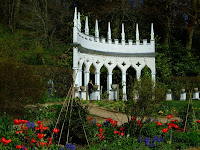 Nearby the town are the Painswick Rococo Gardens. Following discovery of a painting of the gardens as they were in the 18th century, the garden has been restored in the original style and, because this style was only popular for a brief period, these are now the only remaining rococo gardens in Britain.
Nearby the town are the Painswick Rococo Gardens. Following discovery of a painting of the gardens as they were in the 18th century, the garden has been restored in the original style and, because this style was only popular for a brief period, these are now the only remaining rococo gardens in Britain.From here we had an enjoyable country tour on narrow back roads to the very pretty town of Bisley, which cascades down a hillside. An interesting local legend is that Princess Elizabeth died while staying here, and rather than face
 King Henry 8th's wrath, her nurse and the family she was staying with; after failing to find a suitable replacement girl, replaced her with Neville Blunt, a son of Henry's illegitimate son. Neville thus shared a family likeness to the King but not, as has often been remarked upon, to Anne Boleyn, Elizabeth's mother. From here we travelled down the valleys to Chalford, a town once full of mills, and finally to Stonehouse.
King Henry 8th's wrath, her nurse and the family she was staying with; after failing to find a suitable replacement girl, replaced her with Neville Blunt, a son of Henry's illegitimate son. Neville thus shared a family likeness to the King but not, as has often been remarked upon, to Anne Boleyn, Elizabeth's mother. From here we travelled down the valleys to Chalford, a town once full of mills, and finally to Stonehouse.
Subscribe to:
Comments (Atom)

















